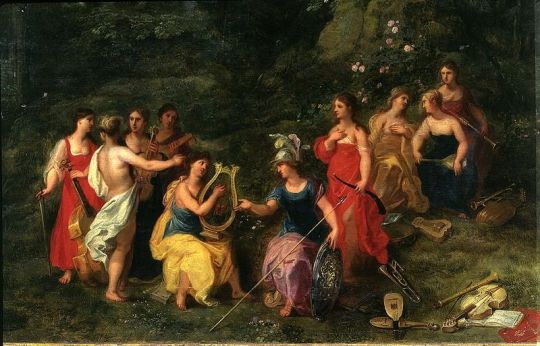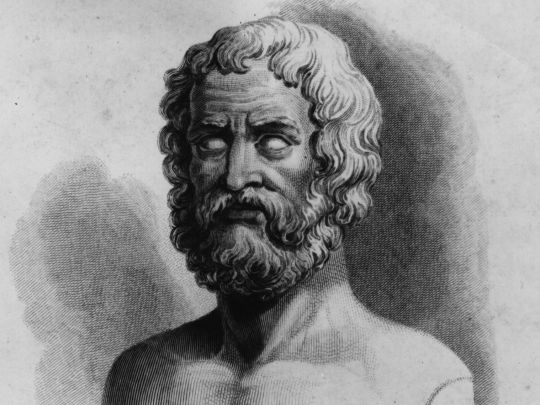Text
Clash of Titans - Perseus’ Ordeal
Every hero has their own journey, and this journey consists of 12 stages.

photo: The Hero’s Journey (12 stages)
In Clash of the Titans (1981), these stages were fulfilled by the hero Perseus. Before he completed all the stages, he first needed to overcome the ordeal or stage 8 of the journey. Let’s look back on the ordeals that Perseus needed to conquer before he was able to seize the reward, shall we?
The Ordeal

photo: The Three Witches
Perseus wants to save Andromeda from the Kraken, but he knows he is not a match for the sea monster. Thus, he sought the advice of the three witches who were blind but had the ability to predict the future and possess great knowledge. However, they were also dangerous for they devour human flesh. Still, Perseus did not hesitate to go to them to seek their knowledge on how he will be able to defeat the Kraken and save Andromeda which he received from them as they told him that only the head of Medusa can help him.

photo: The Dioskilos
The dioskilos were the two-headed beast that resembled a dog. They were guarding and protecting the lair of Medusa, and as Perseus journeyed into his quest into beheading Medusa, he was faced with dioskilos which he has slain to get into Medusa’s lair.

photo: Medusa
The last ordeal Perseus faced before the Kraken was Medusa. She was a monster with snakes in her head and she has the power to turn anyone who looks into her eyes a stone. Considering this, Perseus knew how dangerous it was. So, what Perseus did was, he used his mirror shield to see Medusa without looking at her eyes and that helped him slay and behead her.

photo: Perseus with the head of Medusa
After all these ordeals, Perseus is already prepared to defeat the Kraken with the head and gaze of Medusa. He uses it to save Andromeda and the Kingdom of Joppa from ruin, making him the hero of the story. Then, as a reward, Perseus had a happily ever after with his wife, Andromeda, and received a blessing of protection from Zeus. Very enthralling story, right?
0 notes
Quote
"Shepherds of the wilderness, wretched things of shame, mere bellies, we know how to speak many false things as though they were true; but we know, when we will, to utter true things.”
Hymn to the Muses, Theogony
0 notes
Text
The Beginning of Theogony
Hymn to the Muses ...
The nine muses saw Hesiod under Mount Helicon while he was shepherding his lambs. They approached him and said: "Shepherds of the wilderness, wretched things of shame, mere bellies, we know how to speak many false things as though they were true; but we know, when we will, to utter true things.” then...They plucked and gave Hesiod a rod, a shoot of study laurel, and breathed into him a divine voice to celebrate things as they sing songs to praise the gods and gave Hesiod the knowledge to talk about the gods as a poet.

photo: Mount Helicon
Wonder where the nine muses came from?
The nine muses came to life after Mnemosyne and Zeus lay for nine nights. The nine muses were conceived by this, all with one mind, hearts set upon song, and spirit free from care.

photo: Nine Muses and Apollo
These nine muses are:
Calliope - She is the oldest and the chief among the nine muses. She is the muse of epic poetry and eloquence. According to Hesiod, she held a high status among the muses.
Clio - She is next to Calliope and is also known as the muse of history and creativity. Her role is to take part in political relations between men and nations.
Erato - She is known as the muse of romance and lyric poetry. Her name means lovely, and she makes anyone guided by her worthy of love.
Euterpe - She goes by different names, but she is the muse of music and song. Since she is the muse of music, she is often associated with the flute.
Melpomene - She is one of the two muses of theater. She is the muse of tragedy, and her image is often seen with a mask of tragedy that she carries with her.
Polyhymnia - She is credited as the muse of hymn.
Thalia - She is one of the two muses of theater. She is the muse of comedy; thus, she is depicted as a joyful woman, holding the mask of comedy.
Terpsichore - She is the muse of dance. She is also known as mother of the sirens and often seen playing the lyre.
Urania - She is the youngest of the nine muses and is the muse of astronomy and astrology.

photo: The Nine Muses
Hesiod mentions that if a man suffers with grief and sorrow, and he hears the servant of the Muses chant and sings, he will forget his sufferings and will no longer remember his sorrows. That is the power of the songs of the Nine Muses. After the muses have given Hesiod the blessed voice, the rod, and the shoot of sturdy laurel, he was now able to tell the things that shall be and things that were aforetime.
0 notes
Text
Hesiod
Hesiod - who was he?
Hesiod was a Greek epic poet; he was from Boeotia in the 8th B.C. His work was entitled “theogony,” a cosmological work that describes the origins and genealogy of the gods. From him, we will know the story of the gods. Let’s learn from Hesiod...
0 notes

